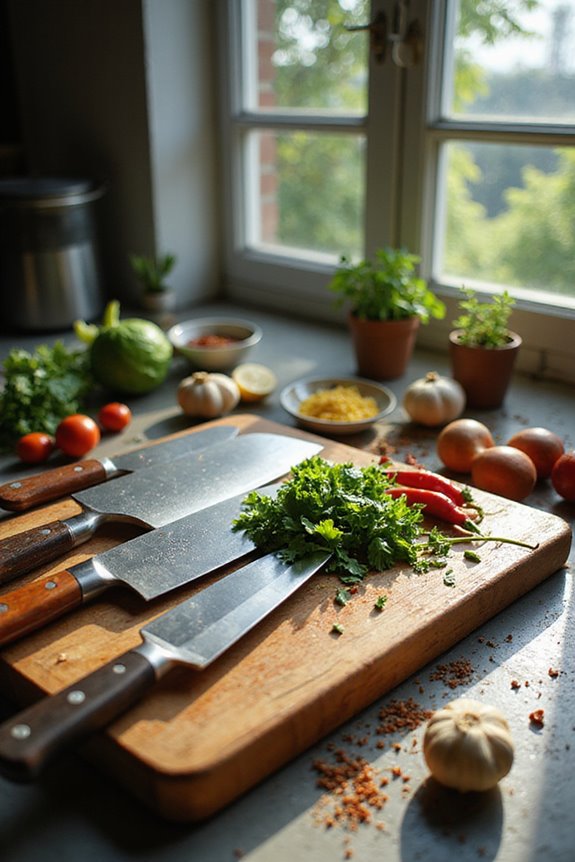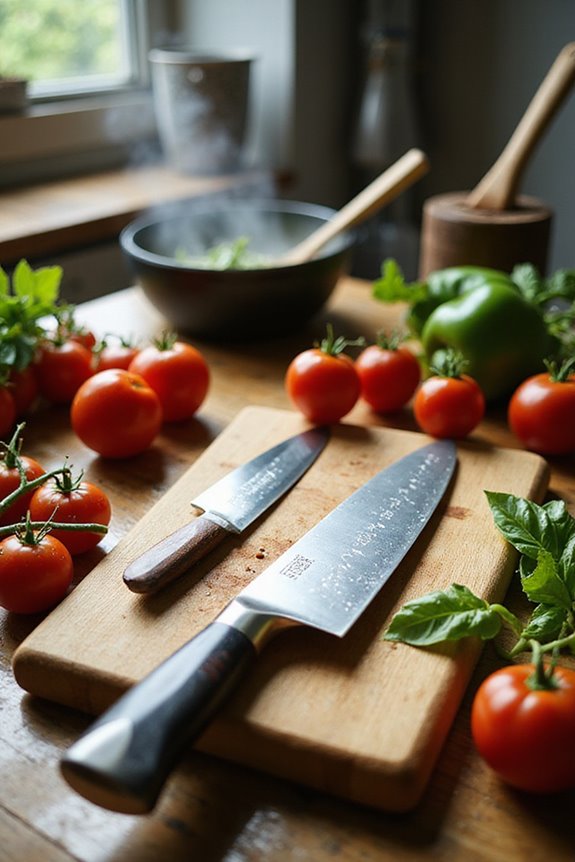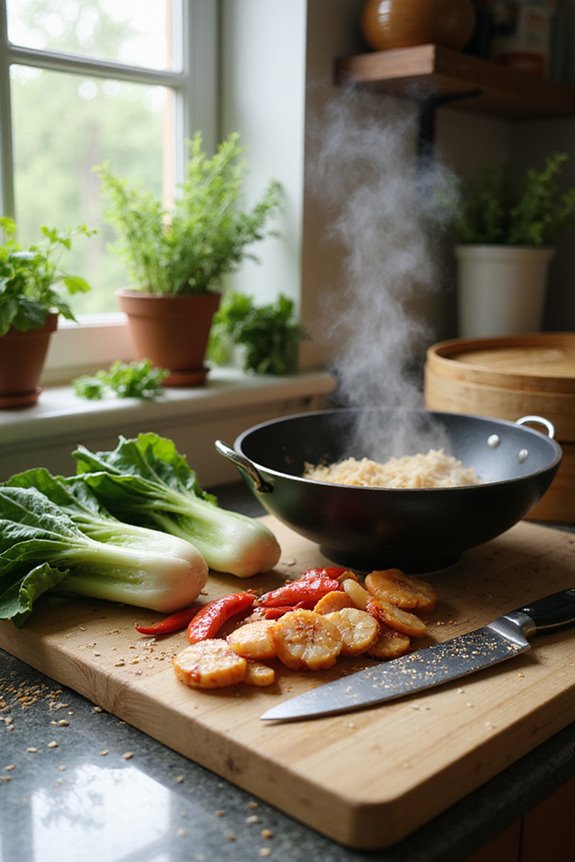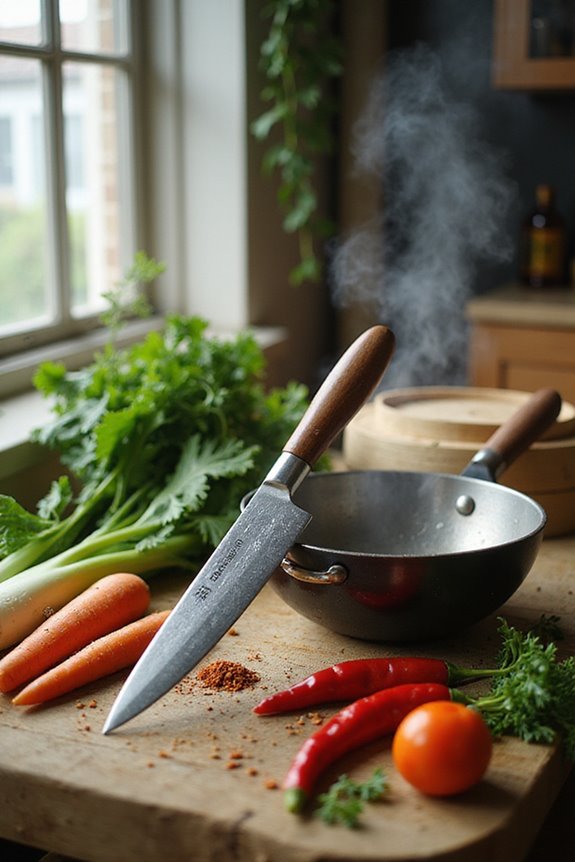As an Amazon Associate, we earn from qualifying purchases. Some links may be affiliate links at no extra cost to you. Although our opinions are based on curated research, we haven't used these products. Articles generated with AI.
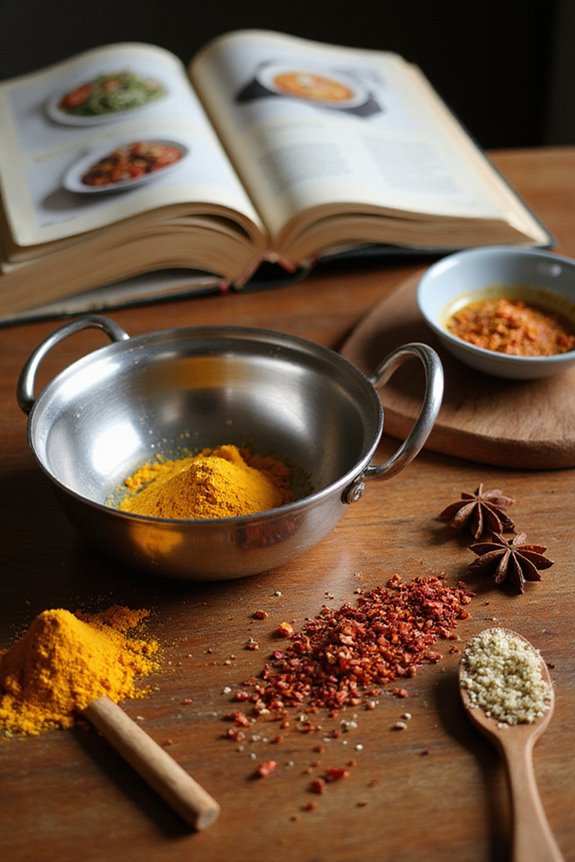
5 Best Chinese Cookbooks to Explore Authentic Regional Cuisines
To explore authentic regional Chinese cuisines, consider these cookbooks: “All Under Heaven: Recipes from the 35 Cuisines of China” which covers diverse regions; “The Every Day Chinese Cookbook,” featuring 365 easy recipes; and “Korean Cuisine,” offering bilingual instructions for traditional dishes. These books cater to various skill levels and provide ingredient substitutions. Understanding regional distinctions is essential when selecting recipes, ensuring you capture the essence of China’s culinary heritage. Discover more about your options ahead.
Key Takeaways
- All Under Heaven: Recipes from the 35 Cuisines of China offers extensive coverage of regional specialties and ingredient substitutions essential for authenticity.
- The Every Day Chinese Cookbook provides over 365 recipes with step-by-step instructions, making it accessible for both beginners and experienced cooks.
- Understanding regional distinctions, such as Sichuan and Cantonese styles, enhances the ability to explore diverse culinary traditions found in Chinese cookbooks.
- Ingredient accessibility is key; look for cookbooks that offer substitutes for hard-to-find items to achieve authentic flavors.
- Historical context within cookbooks enriches the cooking experience and fosters a deeper connection to Chinese culinary traditions.
Maangchi’s Big Book Of Korean Cooking
Maangchi's Big Book Of Korean Cooking: From Everyday Meals to Celebration Cuisine
- Amazon Kindle Edition
- Maangchi (Author)
- English (Publication Language)
If you’re looking for an accessible entry into Korean cuisine, “Maangchi’s Big Book Of Korean Cooking” is a fantastic choice. The book shines with its clear instructions, stunning images, and thoughtful personal stories from the author, Maangchi. You’ll find detailed ingredient insights in the early chapters that help you locate items, which is especially useful when scouring specialty markets. The diverse recipes cater to everyone, including vegetarians and vegans, with plenty of options to experiment. Readers praise its engaging layout and all-encompassing approach, making it a must-have, whether you’re just starting or looking to refine your Korean cooking skills.
Best For: This book is best for home cooks of all skill levels who are interested in exploring Korean cuisine and want accessible, flavorful recipes.
Pros:
- Engaging layout with beautiful photos and personal anecdotes that enhance the cooking experience.
- Detailed ingredient insights that help readers identify items, making it easier to shop for unique Korean ingredients.
- Diverse recipe options, including vegetarian and vegan choices, ensuring there’s something for everyone.
Cons:
- Some ingredients may not be readily available, requiring trips to specialty markets.
- A few readers reported issues with damaged copies upon arrival, which could affect initial enjoyment.
- While there are numerous vegetarian options, the majority of recipes feature meat and fish, which may limit appeal for strict vegans.
All Under Heaven: Recipes from the 35 Cuisines of China [A Cookbook]
Sale
All Under Heaven: Recipes from the 35 Cuisines of China [A Cookbook]
- Hardcover Book
- Phillips, Carolyn (Author)
- English (Publication Language)
For serious home cooks enthusiastic to plunge into the rich tapestry of Chinese cuisine, “All Under Heaven: Recipes from the 35 Cuisines of China” serves as an invaluable resource. You’ll explore over 500 pages that introduce the major culinary regions, from flavorful Hunan to the delicate tastes of Cantonese cooking. While some recipes might challenge beginning cooks, detailed ingredient substitutions guide you through unfamiliar territory. Though it lacks full-color photos, the book’s illustrations clarify essential techniques. Alongside fascinating cultural insights, it provides a deeper understanding of how regional flavors shape Chinese food, making it a must-have for your culinary library.
Best For: Serious home cooks eager to explore authentic Chinese cuisine and expand their culinary skills.
Pros:
- Offers a comprehensive overview of the diverse culinary regions of China.
- Includes detailed ingredient substitutions, making recipes more accessible.
- Features illustrations that clarify cooking techniques, enhancing usability.
Cons:
- May overwhelm inexperienced cooks unfamiliar with Asian ingredients.
- Lacks full-color photographs, which could deter some readers.
- Focuses more on breadth than depth, giving only a broad introduction to each region’s cuisine.
Korean Cuisine (English and Mandarin Chinese Edition)
Sale
Korean Cuisine (English and Mandarin Chinese Edition)
- Used Book in Good Condition
- Choi, Young Sook (Author)
- English (Publication Language)
Korean Cuisine (English and Mandarin Chinese Edition) stands out as the ideal choice for bilingual cooks enthusiastic to explore the vibrant and diverse flavors of Korean dishes. This beautifully illustrated cookbook from Wei-Chuan offers clear, step-by-step instructions in both English and Mandarin, making it easy for you to follow along. Find an ingredient list with pictures to help navigate local grocery stores. You’ll enjoy experimenting with ingredients like dried seaweed or anchovies to enhance flavors. Many users find the recipes approachable, catering to both beginners and experienced cooks, ensuring a satisfying experience while preparing traditional Korean meals.
Best For: Bilingual cooks eager to dive into the flavors of Korean cuisine through clear and approachable recipes in both English and Mandarin.
Pros:
- Bilingual instructions make it accessible to both English and Mandarin speakers.
- Beautiful illustrations and clear layout facilitate easier navigation of recipes and ingredients.
- Variety of traditional dishes allows for exploring both beginner and advanced cooking experiences.
Cons:
- Some users find the bilingual nature confusing, as the book is labeled a Korean edition.
- A few readers prefer other cookbooks for quicker recipes or a more casual cooking style.
- Limited in offering adaptations for different dietary needs within traditional recipes.
The Every Day Chinese Cookbook
Sale
The Every Day Chinese Cookbook: Over 365 Step-By-Step Recipes For Delicious Cooking All Year Round:...
- Hardcover Book
- Doeser, Linda (Author)
- English (Publication Language)
A standout feature of “The Every Day Chinese Cookbook” is its impressive collection of over 365 recipes, making it the ideal choice for anyone looking to explore a wide range of Far East and Asian dishes daily. With over 1600 photographs, each recipe includes step-by-step instructions, ensuring you can easily replicate desired dishes. Users express high satisfaction, often noting that recipes, like the Stir-fried Sweet & Sour Chicken, turn out perfectly on the first attempt. While it uses British English terms—like “groundnut oil” for peanut oil—you’ll appreciate the book’s beautiful layout and straightforward guidance throughout your cooking journey.
Best For: Anyone eager to explore a variety of Far East and Asian dishes daily through easy-to-follow recipes and beautiful visuals.
Pros:
- Over 365 diverse recipes, allowing for daily cooking inspiration.
- Step-by-step instructions complemented by over 1600 photographs, simplifying the cooking process.
- High user satisfaction, with many successful outcomes on the first attempt.
Cons:
- Uses British English terminology which may confuse American English speakers.
- Some users find the text difficult to read due to size or formatting.
- The book’s compact size may not meet everyone’s expectations regarding physical dimensions.
The Everything Peruvian Cookbook
Sale
The Everything Peruvian Cookbook: Includes Conchitas a la Parmesana, Chicken Empanadas, Arroz con...
- Cuadra, Morena (Author)
- English (Publication Language)
- 304 Pages - 02/18/2013 (Publication Date) - Everything (Publisher)
Ever wondered where to discover the vibrant flavors of Peru right in your own kitchen? *The Everything Peruvian Cookbook* offers an incredible gateway into this culinary landscape, perfect for both seasoned cooks and newcomers alike. With over 300 recipes, you’ll explore delights like Conchitas a la Parmesana and Tres Leches Cake. Most ingredients are accessible, but you might need substitutes for unique items like rocoto. The recipes are easy to follow and flavorful, though some instructions may feel vague. While the book could use more visuals, it effectively showcases the essence of authentic Peruvian cuisine, sparking your culinary adventures.
Best For: Those looking to explore authentic Peruvian cuisine through a diverse collection of accessible and flavorful recipes.
Pros:
- Wide variety of over 300 easy-to-follow recipes that cater to adventurous cooks.
- Most ingredients are widely available, with useful substitutes provided.
- Offers a historical context of Peruvian cuisine, enhancing the cooking experience.
Cons:
- Lacks sufficient photographs, which can diminish visual appeal.
- Some recipe instructions may be vague, particularly regarding cooking temperatures.
- Missing iconic dishes such as Lomo Saltado and Aji Verde may disappoint some readers.
Factors to Consider When Choosing a Chinese Cookbook Regional Cuisine
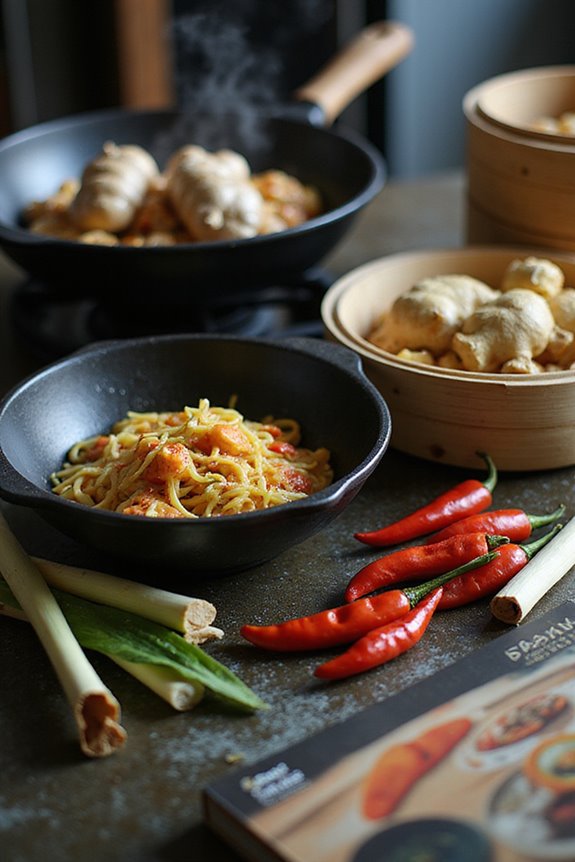
When choosing a Chinese cookbook that focuses on regional cuisine, it’s important to take into account the diversity of flavors and styles found across different areas. Think about the availability of ingredients in your local stores, as well as your own cooking skills and preferences. You’ll also want recipes that clearly explain each step, providing enough context so you can appreciate the rich history behind the dishes.
Regional Cuisine Diversity
Choosing a Chinese cookbook that highlights regional cuisine means exploring the vast diversity within this culinary tradition. Chinese cuisine spans seven major regions, including Sichuan and Cantonese, each showcasing unique flavors and techniques. For instance, you’ll find stir-frying prevalent in Cantonese cooking, while slow-braising defines Jiangsu dishes. Don’t forget the numerous sub-regions, which add even more flavor variation, reflecting local ingredients and culture. For a richer cooking experience, pay attention to how history and geography shape these cuisines. Trade routes and climate variations contribute to local specialties, giving you a deeper appreciation for each dish. By understanding these regional distinctions, you’ll be better equipped to choose the right cookbook for your culinary journey.
Ingredient Accessibility Considerations
Exploring regional Chinese cuisine invites you to think about ingredient accessibility, a factor that can greatly influence your cooking experience. Some recipes in cookbooks may call for authentic Chinese ingredients that your local grocery store might not stock. Consider cookbooks that offer detailed substitution suggestions to help you achieve those desired flavors. Also, specialized regional recipes often require unique ingredients, so knowing where to source them can enhance your dishes’ authenticity. A glossary or index outlining these ingredients is valuable for maneuvering the unfamiliar. Remember, using authentic ingredients tends to produce better flavor profiles, so evaluating your area’s ingredient availability can considerably impact your success with these recipes.
Cooking Skill Levels
Selecting a Chinese cookbook involves more than simply admiring beautiful photographs or enticing recipes; it’s essential to match the cookbook’s complexity with your cooking skill level. If you’re a beginner, look for cookbooks featuring simpler, popular dishes with clear instructions. These will feel more accessible and less overwhelming. Serious home cooks might prefer books focused on authentic regional cuisines that offer intricate techniques, but remember these often assume prior cooking experience. Consider ingredient availability too—some may require specialty items, which can be hard to find. Finally, check the layout and visuals; cookbooks with step-by-step images can greatly enhance user-friendliness, making it easier for cooks of all skill levels to succeed.
Recipe Clarity and Detail
When looking at a Chinese cookbook, the clarity and detail of its recipes can greatly impact your cooking experience. Clear recipe instructions are essential, letting you easily replicate dishes without confusion. Detailed ingredient lists with specific measurements and alternative options guarantee you have everything you need. Step-by-step directions break down complex processes, which is especially helpful for novice cooks. Visual aids, like photographs or illustrations, can improve comprehension and boost your confidence in the kitchen. Additionally, thorough explanations of cooking techniques and regional variations provide valuable context, enriching your understanding of the cuisine. Overall, when selecting a Chinese cookbook, prioritize those that excel in clarity and detail to enhance your cooking journey.
Historical Context Importance
Understanding the historical context of Chinese cuisine enriches your cooking experience, allowing you to appreciate the diverse flavors and techniques that vary considerably between regions. Each area has its own culinary traditions shaped by geography, climate, and agriculture, making it essential to grasp these influences when you cook. Historical events like trade routes and migrations have affected ingredient availability and cooking styles, enhancing your cultural awareness and authentic preparation. Additionally, the fusion of diverse cultural influences, particularly from the Silk Road and colonialism, adds layers to your understanding of Chinese cuisine. By delving into the anthropology of these foods, you’ll dispel common misconceptions, encouraging a deeper exploration of authentic flavors and cooking methods in your culinary journey.
Visual Presentation Quality
Visual presentation quality in a Chinese cookbook can truly elevate your cooking experience. When choosing a cookbook, look for appealing photographs that inspire creativity and serve as references for finished dishes. Step-by-step images alongside recipes greatly enhance usability, clarifying techniques and presentations. A cookbook lacking full-color images might not engage you effectively, as visual elements are essential for mastering the nuances of Chinese cuisine. If photographs are scarce, quality illustrations can still guide you well without overwhelming. Pay attention to the overall layout; easy navigation through balanced text and visuals will streamline your cooking process. Ultimately, a well-presented cookbook can make your culinary journey enjoyable and more intuitive.
Frequently Asked Questions
Are These Cookbooks Suitable for Beginners in Chinese Cooking?
Yes, many of these cookbooks are suitable for beginners in Chinese cooking. They often include clear step-by-step instructions, essential techniques, and helpful tips on ingredient selection. You’ll find simple recipes that introduce you to key flavors and cooking methods, making it easier to build your confidence. Some may even feature illustrations or photos, which can guide you along the way. So, plunge into and start exploring the delicious world of Chinese cuisine!
Do They Include Ingredient Substitutes for Hard-To-Find Items?
When you’re cooking, having the right ingredients is like having a sturdy foundation for a house. Many cookbooks do offer substitutes for hard-to-find items, helping you refine authentic flavors without stress. You’ll find alternatives for common ingredients like soy sauce or bok choy. This guides you in recreating traditional dishes, even if some ingredients remain elusive. Check the book’s index or sections dedicated to ingredient tips for quick reference, ensuring you’re well-equipped.
How Are the Recipes’ Complexity Levels Categorized?
You’ll find that recipes are usually categorized by complexity levels that help you gauge your cooking skills. Often, they range from simple, quick dishes to more advanced, intricate ones requiring several techniques. Each recipe typically includes a clear indication of its difficulty, so you can choose based on your confidence and experience. This system helps you progress gradually, making it easier to develop your culinary skills while enjoying the cooking process.
Are Nutritional Information and Serving Sizes Provided in These Cookbooks?
Many cookbooks include nutritional information and serving sizes to help you plan meals effectively. You’ll often find this information listed at the beginning or end of each recipe. By providing these details, the authors aim to make it easier for you to manage dietary needs and portion control. It’s always a good idea to check if the cookbook specifies this information, especially if you’re following specific dietary guidelines or looking to maintain a healthy lifestyle.
What Kitchen Equipment Is Recommended for These Recipes?
When you immerse yourself in these recipes, think of your kitchen as a craftsman’s workshop. You’ll need essential tools like a wok, a bamboo steamer, and a chef’s knife. Precision matters, so a good cutting board and a set of measuring spoons will serve you well. A rice cooker simplifies your life, ensuring perfect grains every time. Don’t forget a mortar and pestle for spices; they reveal flavors that elevate your dishes considerably.


![All Under Heaven: Recipes from the 35 Cuisines of China [A Cookbook]](https://m.media-amazon.com/images/I/41EykldVV4L.jpg)



